![]()
Vintage lenses are more popular than ever, thanks in large part to the mirrorless revolution as well as affordable, high-quality cinema and hybrid video cameras. These lenses are regularly “cine modded” for video use due to their unique character and less clinical rendering, (sometimes) affordable prices compared to cine lenses, helicoid-driven focus with hard stops, and physical aperture rings (which are often de-clicked).
There are many great vintage lenses that can work with modern mirrorless cameras, and below I’ll cover my top ten choices that you should consider.
Unfortunately, the popularity of using vintage lenses has had the effect of driving up demand, sometimes to what are utterly absurd prices. You needn’t look any further than the insane prices that Canon FD/FDn lenses (particularly the SSC variants) are demanding right now compared to just one or two years ago, partially because they share a lot in common with Canon K35 cinema primes.
Some of these lenses will work on both DSLRs (though this may exclude or have caveats for certain DSLRs, like Nikon F, due to flange distance differences) and mirrorless cameras. Some will only work with their full focus range on mirrorless cameras — this is noted when it is the case.
In this Guide, I have tried to avoid wider (wider than 35mm) focal length rangefinder lenses, as these typically do not work well with many non-Leica mirrorless cameras due to the sensor stack on digital sensors — which film, of course, did not have — and the lack of off-set microlenses. This can produce with images that have soft, smeary corner performance and color shifts due to the shorter exit pupil distance and angle of incidence of wider angle lenses.
However, some non-Leica cameras perform better in this regard than others. The significantly thinner sensor stack of the Nikon Z mount allows it to perform much better than, say, Sony E mount — about 1.0-1.5mm versus roughly 2-3mm respectively, according to Kolari Vision and Roger Cicala in Petapixel’s previous article on sensor stack thickness.
I have also avoided more exotic and pricey optics, such as the Contax Zeiss 2/200 Aposonnar, Contax Zeiss 2.8/300 and 4/400 Tele-Aposonnar, Leica 180/3.4 APO-Telyt-R, to name a few. While these are, to this day, some of the finest lenses ever made, they’re also out of reach for most people and arguably represent more of a collector’s item.
As usual, our recommendations for sourcing vintage lenses (and cameras) in the United States are Robert’s Camera (UsedPhotoPro) and KEH Camera.
At a Glance
Contax Zeiss 2.8/85mm Sonnar T*
Best Use Cases: Mirrorless, Canon EF (Simmod or plain adapter), Nikon F, and Pentax K (Leitax)

There really doesn’t exist a line of affordable vintage lenses that I love more than the Contax Zeiss lenses. These SLR lenses, made by Carl Zeiss in cooperation with Kyocera (who acquired Contax), were designed for the Yashica and Contax C/Y mount 35mm cameras. Zeiss — easily the most highly revered lens maker alongside Leica at the time — had worked with Contax dating back to the 1930s when it designed and produced lenses for the Contax rangefinders. This relationship continued after the Kyocera acquisition in the early 1970 and lasted until the Contax doors were shuttered in the early 2000s.
Zeiss, of course, makes many of its own lenses for numerous mounts today — Otus, Batis, Milvus, Touit, along with a few others like their M-mount line. The Milvus line, made for Nikon F and Canon EF mounts, boasts a number of lenses whose optical design dates all the way back to the Contax Zeiss line.
The 2.8/85 is not one of those, unfortunately — slow lenses faded from fashion, likely due to whims of bokeh fanatics who photograph fence posts and flowers. This peaked with massive, uncompromising lenses like the Sigma Art or Zeiss Otus series, but has since reversed course after several companies — Nikon, Sigma, Tamron, and Sony most notably — have released excellent and compact f/1.8 to f/2.8 prime lenses, as well as zoom lenses like the Nikkor 24-50/4-6.3 and Sony 28-60/4-6.3.
![]()
I had always personally wanted a line of “Mini Otuses” — f/2.5 or f/2.8 versions. We never got that, but we do have the Contax Zeiss 2.8/85 — one of the finest lenses of its time that remains an amazing optic. It could nearly be considered a mini-Otus, particularly stopped down. Wide-open it does not have the consistent across-the-frame resolving power or micro-contrast of the Otus 85, nor is it apochromatic. But once you hit f/4 and especially f/5.6, there’s very little in it between them. Well, except nearly two pounds of weight.
None of that is to say this lens isn’t a stunner — comparing just about any lens to a Zeiss Otus is rather unfair, for many reasons. The Contax 2.8/85 does produce excellent resolution across the board, from wide-open until f/11 or so when you hit diffraction (depending on the camera you’re using it on). It has the traditionally beautiful micro-contrast of most Zeiss lenses, giving even the lowest frequency structures plenty of bite. Flare performance is rather impeccable for a vintage lens, though naturally, modern lenses have upped their game in this regard.
Contax Zeiss 3.5/100mm Sonnar T*
Best Use Cases: Mirrorless, Canon EF (Simmod or plain adapter), Nikon F, and Pentax K (Leitax)

Everything said about the 2.8/85 Sonnar goes for the 3.5/100 Sonnar, and then some.
Yes, it’s even slower than the 85 Sonnar — a bit over half a stop slower, to be exact. But like the 85 Sonnar, it is as petite a lens as you can imagine for a 100mm focal length. Compared to that lens, it’s only 1.5mm larger in diameter (with the same 55mm filter thread) and 14mm greater in length at 61mm, with a mere 26-gram weight difference (260g vs 286g, respectively).
So good is the lens, its MTF (modular transfer function) chart shows there is little improvement to stopping down. Contrast is excellent both wide open and stopped down, with resolution improving and flattening out slightly by f/5.6. As you can see, there is some astigmatism as you move away from the center, likely due to residual spherical aberration. Keep in mind, Zeiss publishes measured MTF charts, not theoretical MTFs — something that no other manufacturer does.
![]()
The 3.5/100 Sonnar features a very similar 5 element/4 group design as the 2.8/85 Sonnar — even simpler than the 7/3 Sonnar design created by Ludwig Bertele in 1932 for the Zeiss Sonnar 50/1.5 (this is not uncommon for longer focal length Sonnar and Tele-Tessar designs).
Pair this lens with the Contax Zeiss 28-70/3.5-4.5 or the 35-70/3.5 (or the 2.8/35 and 1.7/50), the 2.8/85, and the 2.8/135 and you will have yourself a very good all-around kit for walkabout, portrait, and landscape photography. Throw in the next lens on this list for an excellent, full Contax Zeiss kit from 28/35mm to 300mm that won’t break the bank.
Contax Zeiss 100-300mm f/4.5-5.6 Vario-Sonnar T*
Best Use Cases: Mirrorless, Canon EF (Simmod or plain adapter), Nikon F, and Pentax K (Leitax)
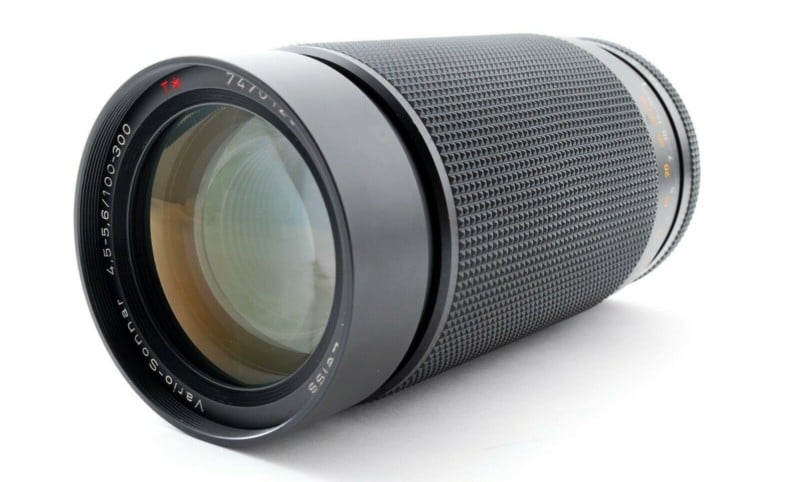
If it seems like I have a personal affinity for the Contax Zeiss line, it’s because I do — and for good reason. There are few lenses in the series that aren’t still good by today’s standards, and several that are excellent. The 100-300mm Vario-Sonnar is one of those, as well the only zoom lens on this list — many vintage zooms weren’t even very good on film, let alone high-resolution digital. The 100-300mm Vario-Sonnar is a real exception. Not only is it a great lens, but it’s also better than many prime lenses in the same range, albeit slower. For someone like me, who uses telephoto lenses a lot for landscape work, this is hardly an issue.
The lens’s MTF chart — which, again, is measured, not theoretical — is impressive even wide-open, with performance becoming excellent by f/8. Resolution and contrast peak between 135mm and 200mm, with a dip in resoling power and acutance at the long end in particular — a common phenomenon with even the best of today’s zoom lenses. But no matter how you spin it, the lens turns in exceptional results at nearly every focal length and aperture, at least until you hit diffraction limits.
![]()
![]()
![]()
![]()
Like a lot of older zooms, the 100-300 Vario-Sonnar is a push/pull design, meaning the focus and zoom ring are integrated — focus is done as usual and zooming is accomplished via pushing to extend the lens (zoom in) or pulling back to retract (zoom out). Push/pull lenses tend to be love or hate — some love them as they find them to be faster and simpler to operate and others (like me) don’t care for them, mainly because manipulating focus after framing can result in an accidental shift.
Even if you are not a fan of the design, it’s a small price to pay for the versatility and results.
Leica 50mm f/2 Summicron-M (V4)
Best Use Case: Mirrorless only.
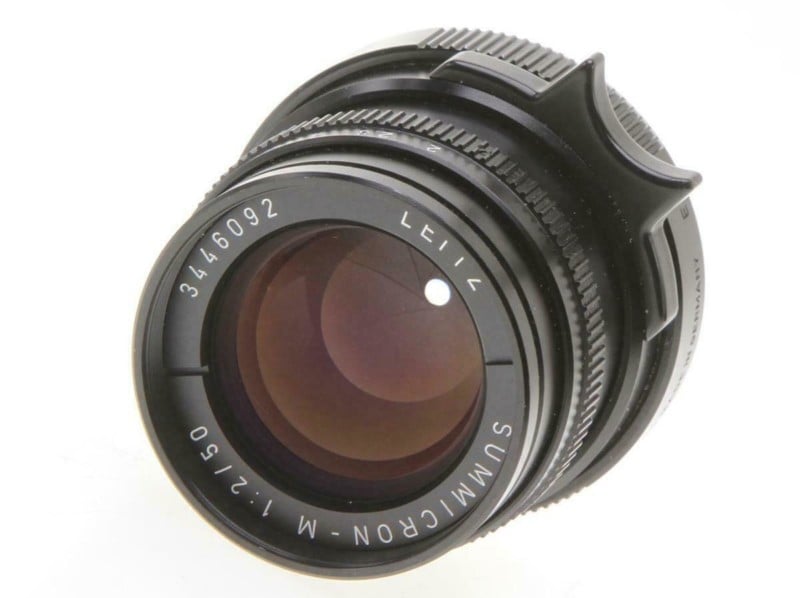
The Leica Summicron is basically a household name among photographers at this point. “Summicron” — derived from a fusion of the Latin words summus and kronos (meaning “maximum” and “time” respectively) — is Leica-speak for any of its lenses with an f/2 maximum aperture. This rule only applies from 1953 to the present day — before then, other f/2 lenses had designations such as “Summar” and “Summitar.” Today, Leica produces M-mount Summicron variants in the 28mm, 35mm, 50mm, 75mm, and 90mm focal lengths — a 40mm Summicron was once produced in concert with Minolta.
The 50mm Summicron is the oldest line and is now in its fifth iteration — six if you count the 50/2 APO Summicron. The first version, released in 1953, was a collapsible design with an LTM (M39) mount and a front element that would scratch if you sneezed on it. The second version moved to M-mount and a rigid design, along with a variant that had an extended near focusing range, earning it the name “Dual Range.” The third redesign moved to the classic black with white and yellow lettering aesthetic and a more traditional 6 element/4 group double gauss (“Planar”) design — the first three versions were 7 element/6 group constructions.
Then, in 1979, we got Version 4 (colloquially “V4”): a similar design as version 3, but with 8 aperture blades instead of 10, and it now featured the lovely focusing tab for the first time. While the (non-APO) 50 Summicrons have progressed to a fifth version since the V4, the differences primarily boil down to the integrated telescoping hood of the newest version — the optics have otherwise remained identical. This means the V4 is one of the most affordable gateways to owning what is essentially a modern Leica lens.
Earlier Summicron V4 lenses were made in Canada, while later versions shifted back to Germany, and its lighter weight compared to the earlier brass versions is thanks to its mostly aluminum build. Resolution is excellent across the board, with a fall-off in the corners and edges that cleans up by f/4. Lateral CA is an issue, but correctable in post. Axial CA is present, though diminishes as you stop down, and flare control is quite commendable for a lens of this vintage.
The Canadian versions are usually a bit cheaper to acquire (much like today’s Made in Portugal variants), so in my opinion, go for that. Some of the best Leica cameras and lenses were produced in Canada; the famous Dr. Walter Mandler, who worked at ELCAN (Ernst Leitz Canada) from 1952 to 1985, pioneered some of the most groundbreaking and revered Leica optics, including the Summicron 50 V4.
Note that you can find some Summicron V4 lenses upgraded with 6-bit coding for use with digital M bodies, or you can have this service performed (or even do it yourself, at your own risk). Mine has been 6-bit modified and such upgraded lenses tend to command a bit more of a resale premium. If you don’t ever intend to use a Leica M digital camera, then it won’t make any difference to you.
Minolta M-Rokkor 90mm f/4
Best Use Case: Mirrorless only
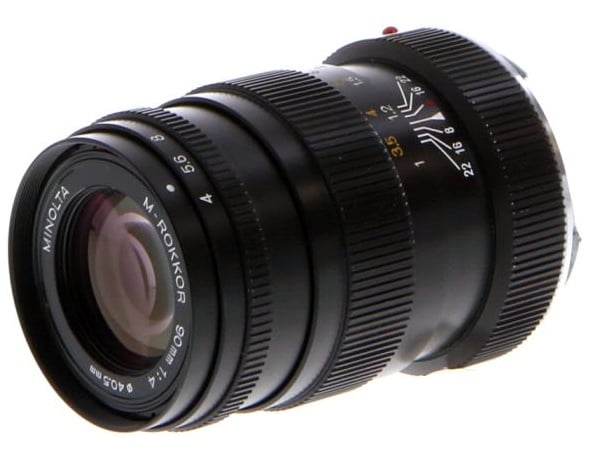
In 1973, Leica partnered with Minolta to develop a new rangefinder, which became the Leitz Minolta CL or Leica CL. This camera was paired with the newly developed Leica Summicron-C 40/2 and the Leica Elmar-C 90/4 — both are ostensibly Minolta designs. Seven years later, the Minolta CLE hit the market: a rangefinder that very closely resembled the Leica CL, though it was developed completely independently from Leica, with many new and groundbreaking features.
Along with the CLE, Minolta released the Minolta M-Rokkor 28/2.8, M-Rokkor 40/2, and M-Rokkor 90/4. The former was a new lens, due to the CLE’s incorporation of a 28mm frame line, while the latter two were optically identical to the Summicron-C and Elmar-C, respectively. The Minolta lenses are, however, multi-coated, resulting in superior contrast, flare suppression, and transmission.
As far as M-mount rangefinder lenses go, 90mm f/4 (or Elmar-type) are among the cheapest. Many of them, the older ones especially, are poor performers by today’s standards, but the M-Rokkor 90/4 is an exception. It’s also cheaper than its Leitz branded counterpart, despite its superior multi-coating.
While some may scoff at a 90mm lens with a paltry f/4 aperture, I am a huge fan of them for several reasons: when used with a rangefinder camera, 90mm lenses below f/4 (and especially below f/2.8) are tricky to hit perfect focus, and 90/4 lenses are insanely compact, while still packing a powerful punch as far as image quality. A lot of my work is landscape, almost always above 50mm, and usually at 85mm or longer. Lenses like the Minolta M-Rokkor 90/4 — or my favorite, the Zeiss ZM 4/85 Tele-Tessar — are perfect for such work, where you’ll probably be stopping down to f/5.6 or f/8 anyway.
The M-Rokkor 90 is one of those petite, super-portable, and ultra-affordable options that any fan of vintage lenses should seriously consider.
Nikon AI-S Micro-Nikkor 55mm f/2.8
Best Use Case: Mirrorless, Canon EF (Simmod or plain adapter), Nikon F, and Pentax K (Leitax)
![]()
Released in 1979, the Micro-Nikkor 55/2.8 AI-S took the place of the older Micro-Nikkor 55/3.5 AI as the company’s mid-range macro optic. While the 55/3.5 was a very good lens, the newer 55/2.8 moved from its predecessor’s 5 element/4 group design to a more advanced 6 element/5 group arrangement with added CRC (“close-range correction”). Obviously, the lens gained a little over half a stop in speed as well, and more advanced coatings were applied to maximize transmission and flare control.
Construction is typical of vintage Nikon AI and AI-S lenses, which is to say it’s solid as a rock. As for performance, the Micro-Nikkor 55/2.8 is bitingly sharp at every aperture, until you hit diffraction anyway, and there is only minor lateral and axial CA to speak of (the latter of which is virtually gone by f/5.6). Not only is it a great performer at every aperture, but it also sings at every distance — unlike other lenses, macro lenses are optimized for close-focus performance, and in some cases, this has been at the expense of image quality at longer distances.
There is one shortcoming: the lens can only achieve a maximum 1:2 reproduction ratio. However, this is easily overcome — shorter focal length lenses require less extension to increase magnification. So, if you want full 1:1 capability, all you need here is a Nikon PK-3 or Nikon PK-13 extension tube — or any equivalent 27.5mm Nikon mount extension tube from third-party manufacturers.
As a bonus, because this lens is completely manual, if you pair it with one of the extension tubes, you can use the amazing Nikon ES-2 film digitizing kit on any full-frame mirrorless body that you wish. If you shoot a lot of film, it’s honestly worth picking one of these lenses up just to be able to use that kit.
Nikon Nikkor AI 45mm f/2.8 P & Contax Zeiss 2.8/45mm Tessar
Best Use Cases: Mirrorless, Canon EF (Simmod or plain adapter), Nikon F (with Leitax for Contax), and Pentax K (Leitax)
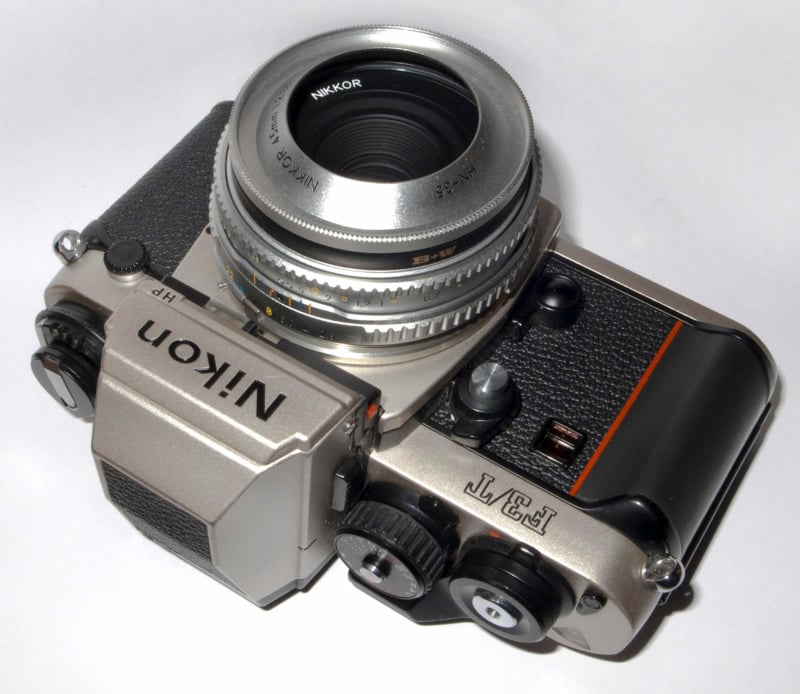
Compact pancake-style SLR lenses have a lengthy history dating back at least half a century. To name a few: Minolta MD Rokkor 45/2, Olympus OM 40/2, Konica AR 40/1.8, München Hexatar 45/2.8, Pentax SMC 40/2.8 and Pentax FA 43/1.9, Voigtlander Ultron 40/2 SL, Meyer-Optik Görlitz Helioplan 40/4.5, Canon EF 40/2.8 STM. And, of course, the Contax Zeiss 2.8/45 and Nikkor AI 45/2.8 P. What do they all have in common? The focal lengths all range from 40mm to 45mm and most of them feature a 4 element/3 group Tessar or Tessar derivative design.
The Tessar design is one of the oldest still in use today. Derived from the Anastigmat, it was developed by Paul Rudolph in 1902 at Zeiss in Germany and features four elements — one positive crown at the front, a negative flint in the center, and a negative plano-concave cemented with a positive convex crown element holding up the rear.
Over the years, the Tessar design was most easily employed, with the best results, in normal focal length lenses — lenses whose focal length roughly matches the diagonal of the film format. For 35mm film, which has a 43mm diagonal, this meant 40-45mm lenses were optimal candidates, and because of the very simple design, the lenses could be extremely small. This came with the caveat that most topped out around f/2.8 — the faster pancake lenses, like the Olympus OM 40/2 or Konica AR 40/1.8, are modified double Gauss (“Planar”) formulas and not quite as thin.
While all these vintage lenses are worth checking out, there are two that stand above: the Nikkor 45/2.8P and the Contax Zeiss 2.8/45. The latter is an older optic, though as you can see with the other three Contax Zeiss lenses on this list, that hardly means anything. No, the Contax 45 is not as technically great as those lenses — wide open it is only a good performer, with some significant residual field curvature and astigmatism. Stopped down to f/5.6, the field curvature persists but becomes more uniform. Resolution and contrast, on the other hand, are exceptional.
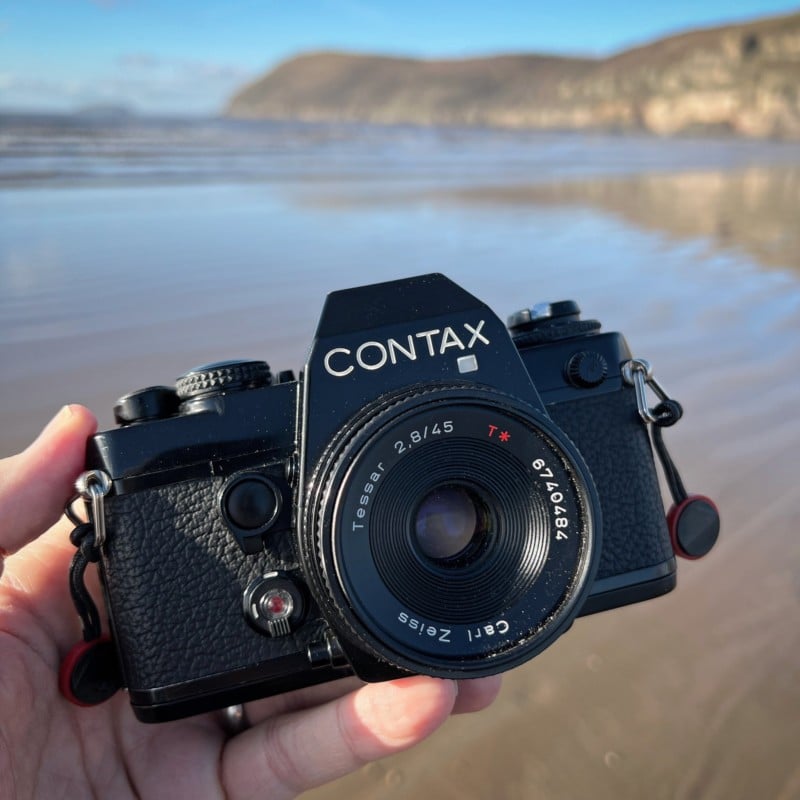
The Nikkor 45/2.8 AI-P is a lens that, I admit, stretches the boundaries of what defines a “vintage lens.” But given that the lens is 1) long out of production and 2) was produced and paired with the Nikon FM3A — a 35mm film camera — I feel justified in including it.
Like The Contax Zeiss 45, the Nikkor features a Tessar design fitted into a body with a paltry length of just 17mm — for reference, that’s almost exactly the diameter of a United States dime. Yes, a dime. The Contax Zeiss 2.8/45 is virtually the same size.
As for performance, the Nikkor is simply stellar. Global resolution is exceedingly high in the center and mid-frame wide-open, and very sharp across 95% of the frame stopped down to f/4 and f/5.6. There is, again, field curvature present. This is simply a consequence of the Tessar design, and my opinion lends such lenses a very gentle but lovely aesthetic.
Just be sure to focus on your subject at the point in the frame — focus and recompose doesn’t work well unless the field curvature of the lens matches the distance change precisely.
Tokina AT-X 90mm f/2.5 Macro
Made for: Canon FD, Nikon F, Minolta SR, Olympus OM, Pentax K
Best Use Case: Mirrorless; Canon EF with adapter (Simmod or plain) or conversion depending on the mount
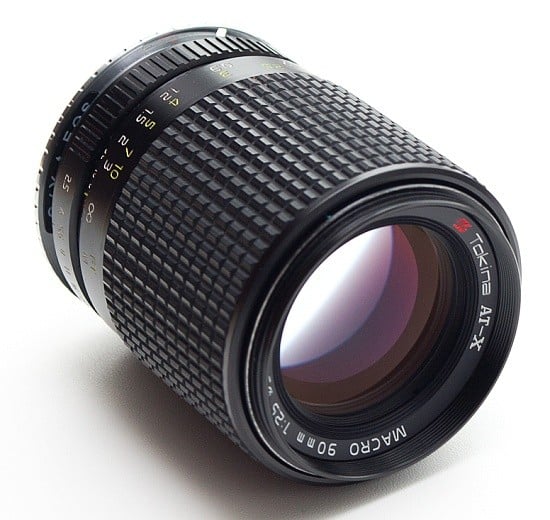
The name Tokina is not one that tends to spark lustful thoughts when we hear it. This is true today, even though the company does make some quality optics, but it was especially twenty-plus years ago. Of every lens on this list, the Tokina AT-X 90/2.5 Macro is easily the most overlooked — most people simply don’t know it exists or understand how it’s different than the hundreds of other similar lenses from various companies during that era.
Nicknamed the “Bokina” this lens has several lovely surprises in store for unassuming users. As you might guess from the clever portmanteau, the lens is highly regarded for its incredibly beautiful, smooth, buttery bokeh. And I don’t use those terms the same way that people describe the look of a Minolta Rokkor 58/1.2 or Jupiter 9 — the Tokina resolves detail extremely well and there is always a very clean, sharp plane of focus from which the rest nicely melts away. This is the signature of a well-corrected optic; spherical aberrations, like those in a Minolta 58/1.2 or Jupiter 9, create a “glowy” or “dreamy” aesthetic, but nothing ever actually seems to be in focus. Conversely, in a highly well-corrected lens — a Zeiss Otus or Leica ASPH or Sigma Art — images are cut cleanly with a distinct plane of focus. This creates the so-called “3D look.”
Somewhat ironically, extremely well-corrected lenses often don’t produce the most pleasing bokeh — they usually incorporate aspherical elements, which can render some harshness to out-of-focus details. This is why one might prefer a Zeiss Milvus 85mm over the Zeiss Otus 85mm for portraiture.
How is all this relevant to the “Bokina”? Well, it renders some of the most pleasing bokeh I have seen from any lens. The only exception is some geometric presentation in the bokeh balls when stopped down (“sawtooth” is how the shape is often described). Personally, I don’t mind non-circular bokeh balls — Cooke lenses are among my favorite cinema optics partially for that very reason.
While the bokeh is extremely smooth, it still maintains the necessary abrupt transitions in front of and behind the plane of focus (note that abrupt is not the same as harsh). What makes for nice bokeh, without resorting to fancy and cliché terms? In general, we want to see nice, uniform blur across the out of focus elements, no double-imaging, pleasingly shaped highlights (or bokeh balls) without odd internal patterning, no outlining (which results in “nervous” bokeh), and minimal lateral and axial CA (spherochromatism). The Bokina hits every point — even its foreground bokeh is insanely smooth, which is not always the case for lenses with very smooth background blur.
It doesn’t stop there, because I — someone who thinks shallow depth of field and bokeh obsession is just silly — would never recommend a lens solely on that basis alone. Luckily, the Bokina is also deserving of at least one or two other clever nicknames; this lens is insanely sharp, at every aperture, at every distance, at every point in the frame. The very extreme corners need f/4-5.6 to sufficiently match the rest of the frame, but after that, it’s a wash until you hit diffraction. This performance remains true at the lens’s closest 1:2 reproduction ratio.
Nothing is perfect and if we nitpick, the coatings aren’t nearly in the same class as, say, Zeiss T* — strong light sources near the edges of the frame can wash the image out considerably, but this is easily avoided by either paying attention or using a hood. There’s also a decent amount of purple fringing at f/2.5, but it disappears entirely around f/5.6. Honestly… that’s about it. It’s that good.
The Tokina AT-X 90/2.5 may be the most versatile lens on this list. It’s a phenomenal portrait lens. Stopped down it’s as good of a landscape lens as one could ask for from a vintage optic. If you can live with the 1:2 magnification, it’s a fantastic macro lens. It’s also readily available for under $250.
It’s a true gem.
Voigtlander 180mm f/4 APO-Lanthar SL
Made for: Most commonly Nikon F, Pentax K, and M42 mounts, but also reportedly made in Contax C/Y, Olympus OM, and Canon FD.
Best Use case: Mirrorless with an adapter.

This one is a bit of a rarity. Not super rare — it’s regularly available on eBay at any given time and pops up at Robert’s Camera or KEH Camera with decent frequency. But it is a lesser-known optic that was produced in very limited quantities — reportedly about 1,000 to 1,300 units across various mounts — alongside the even rarer Voigtlander 125/2.5 Macro APO-Lanthar and the far more common Voigtlander 90/3.5 APO-Lanthar.
This lens does skirt the boundaries of what one could call “vintage.” Even at my ripe age of 32, the idea of a lens produced in the early 2000s being dubbed vintage makes me wince a bit. However, I am justifying its placement on this list because it 1) is among the best lenses ever made, 2) is no longer in production, and 3) was produced not only in Nikon F and Pentax K mounts but also in legacy mounts like M42, which are, by any definition, vintage mounts.
The most common version to find is the Nikon F variant. It is a chipped AI-S lens, meaning it works with legacy film cameras as well as any modern digital Nikons, with the ability to transmit EXIF data and aperture control electronically.
Did I mention it is one of the best lenses ever made? Image quality is outstanding across the board, from wide-open until you hit diffraction. It is a truly apochromatic design, meaning axial CA is nonexistent, with a superb ability to describe and resolve high-frequency detail (microcontrast). Global contrast (or macrocontrast) is on the low side, but I don’t mind this — it helps preserve dynamic range in extreme conditions.
Perhaps best of all, the lens is very, very small: 3.1 inches in length, though it extends considerably when focusing, with a tiny 49mm filter thread. Holding it in your hand, you’d be forgiven for thinking it’s more like a 100mm lens.
This is one of my all-time favorite lenses and, I do not say this lightly, is up there in performance with the Zeiss Otus, Leica M APO, Zeiss 2/135 APO Sonnar, and some of the recent Nikon Z lenses (and yes, plenty of others too from whichever brand you are about to defend). Don’t let its diminutive size fool you — this lens packs a hell of a punch.
W-Nikkor-C 3.5cm f/2.5 LTM and W-Nikkor-C 3.5cm f/3.5 LTM
Best Use Case: Mirrorless only
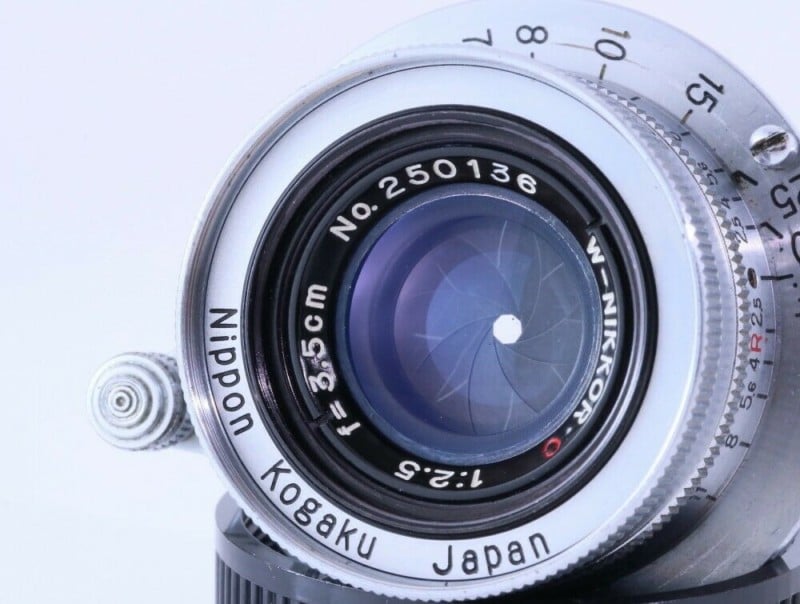
Lest I be accused of being a perfectionist snob when it comes to lenses, or that I only appreciate “clinical” or “soulless” lenses, I decided to include two of my favorite little vintage gems that are among my favorite not because of their perfection but in spite of their lack of it. For the record, what I value in lenses is transparency and clarity — lenses that simply do their job and get out the way without imparting their own optical maladies onto the image. For the majority of my work, this is what I need.
But one look at my shelves and dry cabinets would show how much I appreciate an uncoated Leica 50/2 Summar, a swirly Summitar, a characterful Jupiter 3, a tiny Chiyoko Rokkor 45/2.8 LTM, a slow but wonderful TTArtisan 28/5.6, a quirky MS Optics 24/2 Aporia, and so on and so on. I’m even about to pull the trigger on a Chinese 50/1.1 M mount lens that you likely haven’t even heard of — is it special in any way? Not at all. I don’t consider myself a collector because I do actually use my collection, but I do have one nonetheless, and I enjoy adding to it.
And part of that collection is a W-Nikkor-C 3.5cm (35mm) f/3.5 LTM (Leica Thread Mount) lens. I’ve listed it alongside its faster sibling, the f/2.5 version, simply because there is very little difference other than that speed. Well, except the price — the W-Nikkor-C f/2.5 is about twice the price of the f/3.5.
These lenses came about during a particularly competitive period in the history of photography — after the Second World War, Japan was in ruins, and Germany, the home of Leica and Zeiss, who had dominated the world of cameras and optics until that point, was in a state of constant flux and uncertainty. I cover this more in detail in my article about the creation of the Nikon F, but essentially, during the 40s and 50s, Nikon was producing its own rangefinder cameras with its own mount, as well as lenses for Leica’s M39 thread mount. These lenses became very popular due to their high optical and mechanical quality and low price.
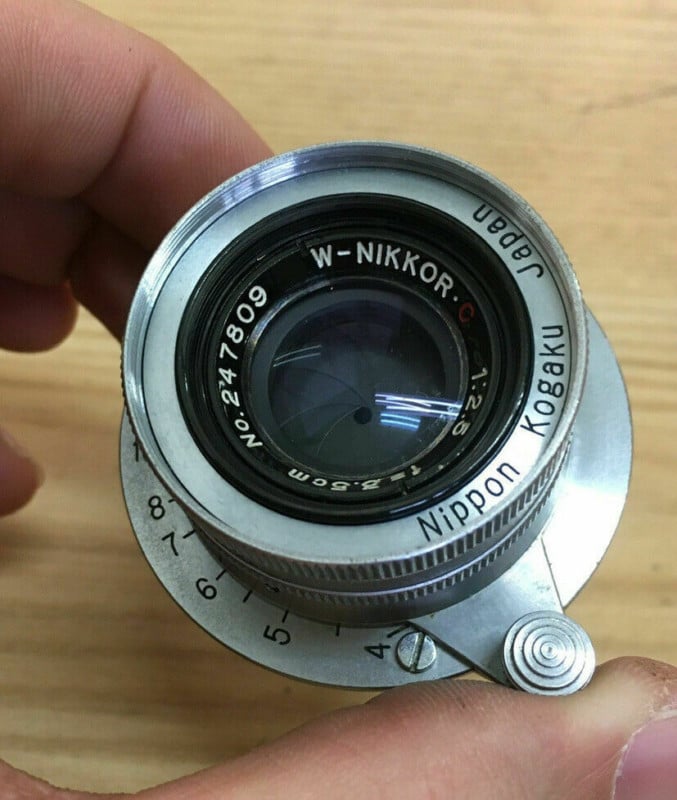
These two W-Nikkor-C 3.5cm lenses are a product of that time. Absolutely tiny — you could probably fit five in your pocket — they are by no means perfect lenses. The coatings are soft and delicate, aberrations abound wide open, and so on, but what they are is incredibly fun. Wide-open they produce perfectly acceptable, slightly ethereal images, but stopped down they become surprisingly sharp across the frame — in large part thanks to their not-so-simple symmetrical double Gauss design — with nice contrast and just generally pleasing image quality. As a neat little bonus, the f/2.5 variant has a very cool aperture blade orientation at its middle f-stops — it reminds me a lot of Cooke cine primes.
The LTM mount is a great mount for universal use — it can be used on everything from a mirrorless Sony or Nikon or Fuji to a Leica M11 to a Barnack Leica to a Leica M4 to a wide number of 35mm LTM rangefinders from Canon and other manufacturers.
If you love normal focal lengths, moderate speed vintage rangefinder lenses that you can slip in your pocket, then look no further.
Bonus Options
While those ten are my top picks, there are several others worth considering:
- Canon Serenar 28/3.5 LTM
- Canon FD 300/4 L
- Contax Zeiss 2/28 Distagon
- Contax Zeiss 2.8/135 Sonnar
- Contax G 2/45 Planar
- Contax G 2.8/90 Sonnar
- Kobalux (Avenon) 28/3.5 LTM
- Leica 60/2.8 Macro-R
- Leica 135/4 Elmar-M
- Minolta M-Rokkor 40/2
- Minolta MD 100/2.5
- Nikkor AI-S 180/2.8 ED
- Olympus OM 100/2
- Ricoh GR 28/2.8 LTM
- Zeiss ZM 4/85 Tele-Tessar
- Zeiss 2/135 APO-Sonnar
Author: Matt Williams
Source: Petapixel



